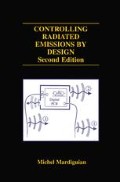Abstract
During the first part of the twentieth century, electromagnetic interference (EMI) was primarily a concern for telecommunications via wire and radio. In these specific engineering communities, highly qualified engineers developed quite sophisticated analytical approaches to predict interference levels, taking into consideration the sources’ parameters, the propagation media and the sensitivity of the pertinent telephone or radio receivers. The typical sources of EMI until the 1960s were natural atmospheric noise, motor commutators, fluorescent lights, automobile ignition systems and 50/60 Hz overhead lines (unintentional sources), plus jamming by other authorised (and sometimes unauthorised) radio transmitters.
Preview
Unable to display preview. Download preview PDF.
Rights and permissions
Copyright information
© 2001 Springer Science+Business Media New York
About this chapter
Cite this chapter
Mardiguian, M. (2001). Generalities on Radiated Interference. In: Controlling Radiated Emissions by Design. The Springer International Series in Engineering and Computer Science, vol 580. Springer, Boston, MA. https://doi.org/10.1007/978-1-4615-4357-2_1
Download citation
DOI: https://doi.org/10.1007/978-1-4615-4357-2_1
Publisher Name: Springer, Boston, MA
Print ISBN: 978-1-4613-6958-5
Online ISBN: 978-1-4615-4357-2
eBook Packages: Springer Book Archive

